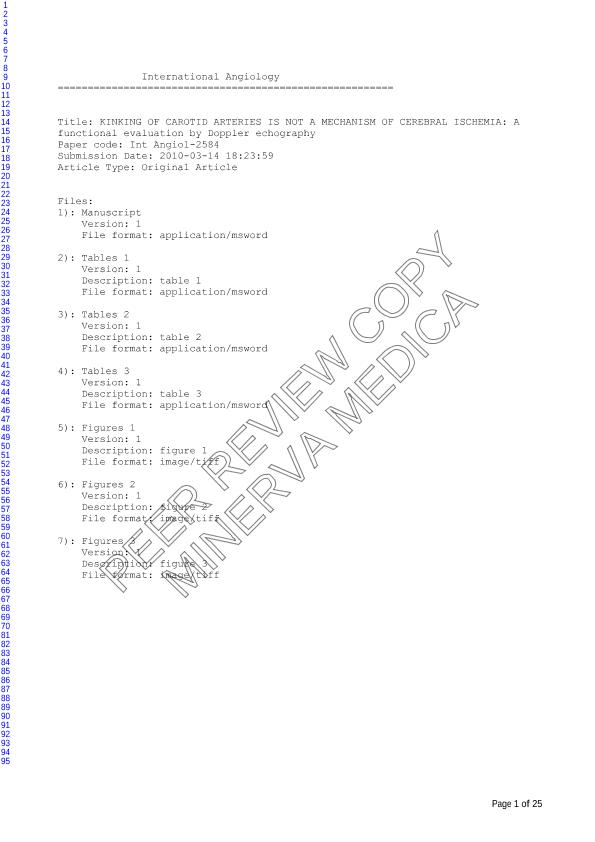Mostrar el registro sencillo del ítem
dc.contributor.author
Beigelman, Ricardo
dc.contributor.author
Izaguirre, Andrés M.
dc.contributor.author
Robles, Martin Cruz

dc.contributor.author
Grana, Daniel Rodolfo

dc.contributor.author
Ambrosio, Giuseppe

dc.contributor.author
Milei, Jose

dc.date.available
2020-04-15T20:37:07Z
dc.date.issued
2011-08
dc.identifier.citation
Beigelman, Ricardo; Izaguirre, Andrés M.; Robles, Martin Cruz; Grana, Daniel Rodolfo; Ambrosio, Giuseppe; et al.; Kinking of carotid arteries is not a mechanism of cerebral ischemia: a functional evaluation by Doppler echography; Edizioni Minerva Medica; International Angiology; 30; 4; 8-2011; 342-348
dc.identifier.issn
0392-9590
dc.identifier.uri
http://hdl.handle.net/11336/102689
dc.description.abstract
Aim: To evaluate the hemodynamic behavior of carotid kinking, as assessed by color Doppler ultrasonography at baseline and during neck movements, and their relation to neurological symptoms. Methods: In this cross-sectional study, 60 consecutive patients with non atheromatous carotid kinking in whom diagnostic color Doppler ultrasonography investigation of neck vessels had been requested for clinical suspicion of atherosclerotic disease were evaluated. To evaluate if there were significant changes of blood velocities as a consequence of kinking, for each carotid artery we recorded systolic and diastolic velocities both in the segments proximal to kinking, as well as intra-kinking. And the effects of postural changes and neck movements on carotid blood flow were also studied. Results: Flow in carotid arteries with kinking was always normal, and no differences were found between flow velocity measured at the level of kinking compared to the normal tract of the vessel. During head rotation tests, flow remained largely unaffected, a substantial reduction in the velocities in the ophthalmic artery was found in 13.5% of the cases, while an increase was recorded in 27%; and no symptoms or events were recorded during the study. None of the patients referred symptoms, nor were neurological events or signs detected during the maneuvers. Conclusion: Our results show that carotid kinkings are not a mechanism of acute cerebral ischemia, and therefore are unlikely to be a cause of neurological events or symptoms.
dc.format
application/pdf
dc.language.iso
eng
dc.publisher
Edizioni Minerva Medica

dc.rights
info:eu-repo/semantics/openAccess
dc.rights.uri
https://creativecommons.org/licenses/by-nc-sa/2.5/ar/
dc.subject
Kinking
dc.subject
Doppler
dc.subject
Flow Velocity
dc.subject
Ultrasonography
dc.subject.classification
Medicina Critica y de Emergencia

dc.subject.classification
Medicina Clínica

dc.subject.classification
CIENCIAS MÉDICAS Y DE LA SALUD

dc.title
Kinking of carotid arteries is not a mechanism of cerebral ischemia: a functional evaluation by Doppler echography
dc.type
info:eu-repo/semantics/article
dc.type
info:ar-repo/semantics/artículo
dc.type
info:eu-repo/semantics/publishedVersion
dc.date.updated
2019-01-04T16:30:24Z
dc.journal.volume
30
dc.journal.number
4
dc.journal.pagination
342-348
dc.journal.pais
Italia

dc.description.fil
Fil: Beigelman R.
dc.description.fil
Fil: Izaguirre AM.
dc.description.fil
Fil: Robles M.
dc.description.fil
Fil: grana.
dc.description.fil
Fil: Ambrosio G.
dc.description.fil
Fil: Milei, Jose.
dc.journal.title
International Angiology

dc.relation.alternativeid
info:eu-repo/semantics/altIdentifier/url/https://www.minervamedica.it/en/journals/international-angiology/article.php?cod=R34Y2011N04A0342
Archivos asociados
